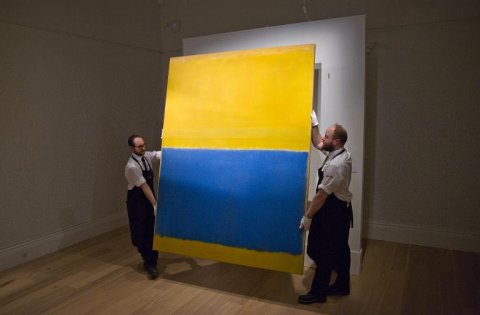 This is part 3 of 4 in a "Freelancing School" series. Check out the other parts using these links:
This is part 3 of 4 in a "Freelancing School" series. Check out the other parts using these links:
- Part 1: What to Expect in Your First Year
- Part 2: Building Your Freelance "Brand"
- Part 3: Make More Money - Getting Through Your Freelance "Plateau"
- Part 4: How to Keep Your Business Growing
Pledge anytime on Patreon to get the full ebook in February! Here's what is covered in this week's blog post on MAKING MORE MONEY:
- The not so secret, secret
- Artists' pay insecurity
- Plateaus and why they don't exist
- Setting financial goals in actual numbers
- Charging per project instead of by hour/day
- Lateral movies and other options
... there's also a "Too Long Didn't Read" section at the bottom if you just want the gist! So let's not waste anymore time and get into the good stuff! Listen to this blog post as a podcast!
Or via SoundCloud if you prefer...
bury the lede One of the benefits of freelancing is that you're your own boss. One of the drawbacks of freelancing is that you're your own boss. The fact is that you have no office to walk into and ask for a raise or a holiday bonus. If you want a raise, you have to give a raise to your entire business. That is much easier said than done, though. There are basically three ways you can get more money coming in. You can:
One of the benefits of freelancing is that you're your own boss. One of the drawbacks of freelancing is that you're your own boss. The fact is that you have no office to walk into and ask for a raise or a holiday bonus. If you want a raise, you have to give a raise to your entire business. That is much easier said than done, though. There are basically three ways you can get more money coming in. You can:
- raise your rate
- get more work
- work more hours (if you're on an hourly rate instead of a per-project one - we'll get to that later).
... that's it. Secret over. You may need the question answered "how to get more work." Here's the answer: find out who needs work and tell them why you're the person for the job... and do that a lot. You may need the question answered "how to work more hours" which I kind of already addressed in my ever-popular productivity post/podcast. But at some you'll arrive a plateau of monetary gain and it will feel like you have no more options left to try. You may be to the point where you need to consider growing your business and diversifying your income (that will be next week's topic), but if not... you need to raise your rate.
Fluctuations in your salary work a lot like weight; and changing your salary is like dieting. The basic idea of dieting is "calories-in vs calories-out." If you're taking in more than what's going out, you'll gain weight. It's the same with your salary. Understand that no matter how many times someone hears this, it doesn't seem to get easier. A lot of new freelancers I talk to respond with "but I already have raised my rate a few times." It's tricky, I'll grant you, because there is a limit to how high you can raise your rates before you start needing to offer something substantially more appealing to your services... but I bet you haven't met that limit yet. Raise your rate.
There's something you'll eventually have to overcome as a Freelance Animator that I've come to call the "artists' pay insecurity." Artists are fueled by their own motivations, mostly, which culminate in some form of inspiration. But if that's the fuel, the oil to keep the engine running smooth is appreciation. This gets back to an idea we deal with a lot on the podcast which is subjectivity vs objectivity.  Take the example of this Rothko painting which sold for $46.5 million at a Sotheby's auction in New York last year. Most people would find that ridiculous... unless you're an art collector. The person buying this piece didn't look at that giant-tile looking, blue & yellow colored painting and think "mm that looks nice... I like that in a quantity the equivalent worth of $46.5 million." Most likely the person recognized the art historical significance of owning a signature style "multiform" piece by Mark Rothko, one of the most famous abstract expressionists. The money that collector paid wasn't based on artistic appreciation but on the recognition of what owning it meant as an investment. So let's separate pay from appreciation because they're rarely equatable.
Take the example of this Rothko painting which sold for $46.5 million at a Sotheby's auction in New York last year. Most people would find that ridiculous... unless you're an art collector. The person buying this piece didn't look at that giant-tile looking, blue & yellow colored painting and think "mm that looks nice... I like that in a quantity the equivalent worth of $46.5 million." Most likely the person recognized the art historical significance of owning a signature style "multiform" piece by Mark Rothko, one of the most famous abstract expressionists. The money that collector paid wasn't based on artistic appreciation but on the recognition of what owning it meant as an investment. So let's separate pay from appreciation because they're rarely equatable.
Payment isn't a compliment, it's compensation for services rendered (which is often also met with an extra bonus of how valuable your "name" or "brand" is). Artists sometimes treat pay like a pat-on-the-back... like they want someone to just give them the money because they don't want to ask for it. After all, nobody likes to ask for a compliment. If that's you right now, you need to get over that fast. Your animation is worth what you say it is - how much of that "worth" you'll actually receive from the client is relative to how much they value you. That gets played out sometimes in negotiation but don't mistake what we do for some used car salesmen tricks... it's simply about everyone getting something they're happy with. Hiring a Freelancer isn't bargain shopping and most clients know that (especially the ones you're getting in your 3rd year).
There's something that happens in everyone's Freelance life at some point or another: reaching a "plateau." A freelance plateau is a little complicated because it's about the balance of all the factors which go into your work. Your freelance animation business at this point in year 3 is probably made up of the following:
- Your rate (aka $$)
- Number of hours in a day you can work
- The quality of your art
- Your efficiency in producing animation
That will result in your salary and the quantity of work produced. Essentially, as I pointed out in the start of this post, if you can't give significant growth to any of those bullet point areas listed above, one or both of the previously mentioned results will stagnate... and that's your freelance plateau. I don't particularly like the use of the word "plateau" because... this is a plateau: 
That flat-top part there - that's the plateau. I'll often see posts that say "break through your plateau" or "plateau busting" tips... that's a mixed metaphor. It's not a barrier, it's a flat geological formation and I think the word implies that there's nowhere else to go. But it's the word everyone is accustomed to when talking about stagnation so I've used it for communication purposes. The key to getting yourself out of a Freelance Plateau is to stop looking at it as something that actually exists... because it doesn't. It's just a moment in time where your growth has stagnated and there is something you're not seeing and/or doing to change that. There is no plateau. 
"Make more money" is not a good goal. There's nothing specific to aim for and no numbers to track progress. You want to set salary goalposts so you can take your "envisioned" goal and turn it into an "envisaged" one. You probably already have an idea of what you want to raise your salary to this year, just make sure to be realistic about it. If your salary progress has been halted, just getting out of it will be hard so you probably won't make your first few goalposts, but having modest goals will help you not to lose heart when you inevitably fall behind on those goals. I recommend taking your goal salary for the year and then divide by 10 to get your monthly goal. This can account for vacation time, sick days, and those times you're simply not getting work (it happens even in the best of years). That monthly goal will give you all the information you need:
- How many jobs you need to get
- What you'll need to charge for those jobs
- How long you can spend on each job (relative to their budget)
 So let's say that you're looking at the month of January and you have 3 jobs lined up: two of which will end in January and one will end in February. You can take your monthly goal, times it by 2 (because you're covering January and February) and then quote each of those jobs a rounded up portion of that total. Example:
So let's say that you're looking at the month of January and you have 3 jobs lined up: two of which will end in January and one will end in February. You can take your monthly goal, times it by 2 (because you're covering January and February) and then quote each of those jobs a rounded up portion of that total. Example:
- If your monthly goal is $4000
- You have 3 jobs starting in January and finishing in February
- You need those 3 jobs to add up to at least $8000 (to cover the two months)
- $8000/3 = $2666.67
- Round up $2666.67 to $3000
- Quote those jobs at $3000
This is crude math but it should get the point across. You need to weigh your opportunities against your goals and quote accordingly. But the most important thing is to give your client something worth what you quoted. You've made the goal... great. But your client is the one paying you for your work so now that you know what you need to get yourself out of this rut and you've quoted as such, deliver on that promise. Clients will come back to you if you deliver something they're happy with and do so on time... regardless of price.
 This might surprise people, but having an hourly or daily rate actually limits your earning ability. I think most people (especially new Freelancers and even some clients, usually white & lower red chip) think of an hourly rate as an open ended potential to earn tons of money... it's not. It's an illusion which gives too much control to the client. One of the huge benefits to freelancing is that balance you can have between client and contractor. But there are a few things that happen when you charge by hour:
This might surprise people, but having an hourly or daily rate actually limits your earning ability. I think most people (especially new Freelancers and even some clients, usually white & lower red chip) think of an hourly rate as an open ended potential to earn tons of money... it's not. It's an illusion which gives too much control to the client. One of the huge benefits to freelancing is that balance you can have between client and contractor. But there are a few things that happen when you charge by hour:
- you're limited by time
- no ability to plan for income
- project scale can change, and with it your total pay
- does not account for ultimate usage
It's that last one which is usually most beneficial to larger corporations. In Freelance Animation, part of what you're doing is selling the rights to the art you make. The same animation for a small scale job which will be seen by a few thousand people should be quoted less than one with a consumer base in the millions. With a rate based on time worked, this scaling is impossible. When you charge per project, your salary becomes scalable to your efficiency: the faster you work the higher your "effective" per hour rate is.
- Be honest, don't swindle. Artists are usually terrible liars and it probably doesn't suit you. Like I said before, if you quote a higher price you should deliver on that. But just remember that the longer you're in the business and the bigger named clients you have in your resume the more cache you have to your brand... that will legitimately raise the price by itself.
- Use an "exclusivity" addon As a Freelancer you're often working multiple jobs and sometimes the client wants to know that they have you all to themselves. But they need to know that it's a risky premise for you (putting your eggs in one basket, and all). You can tell them that for an added fee you'll work exclusively on their project for that month, after which you'll take other projects in tandem whether you're done or not (so you don't get stuck working on an exclusive project forever)
- Add a "rush order" price If you quote a project at taking you 6 weeks to finish and they would like it done in 4, you can tack on an extra cost for getting it done in that timeframe like a store's rush delivery.
This 4-part Freelancing School series is part of an ebook I'm releasing in February which will have more detailed information on exactly how to build your freelancing business. This blog post is a general taste of what will be in the ebook which you can download by becoming a Patron at any level on my Patreon page. Thanks for supporting!
 (for my international readers and people who care not for sports, both of those throws are a called lateral passes... it'll make sense in a bit) Sometimes the niche that you have carved out for yourself goes stale... and that's OK, it's not the end of the world. There are always new areas of animation that are opening up and there's always a hot new style. I'm not saying you need to chase every fad but what we're talking about here is being in and getting out of a rut that has seen your salary stagnate, and if getting out of that means moving laterally into a different area of freelance animation that might be something you'll want to do. Lateral is an adjective which means "from the sides"... so in this case we're talking about when your path forward is blocked, sidestepping to an area where the path ahead is clear. Just like in the GIF above, twice the man with the football had the path in front of him blocked... so he passed it laterally (to the side without directly advancing) to someone whose path ahead was clear. I think the comparison to a football team is appropriate because as a Freelancer you wear many hats, do many jobs, play many positions... you're the whole team.
(for my international readers and people who care not for sports, both of those throws are a called lateral passes... it'll make sense in a bit) Sometimes the niche that you have carved out for yourself goes stale... and that's OK, it's not the end of the world. There are always new areas of animation that are opening up and there's always a hot new style. I'm not saying you need to chase every fad but what we're talking about here is being in and getting out of a rut that has seen your salary stagnate, and if getting out of that means moving laterally into a different area of freelance animation that might be something you'll want to do. Lateral is an adjective which means "from the sides"... so in this case we're talking about when your path forward is blocked, sidestepping to an area where the path ahead is clear. Just like in the GIF above, twice the man with the football had the path in front of him blocked... so he passed it laterally (to the side without directly advancing) to someone whose path ahead was clear. I think the comparison to a football team is appropriate because as a Freelancer you wear many hats, do many jobs, play many positions... you're the whole team.
I used to get a lot of work in game animation, that was a big thing at one point in time. The next big thing after that was banner ads, which I wasn't entirely keen on creatively but it helped me continue to progress my career and salary. Lately I've been contacted to do a lot of explainer videos and even those are on the wane now. To keep growing, I move into different areas where advertisers or parent companies are allocating unusually large funds. My main job is always character animation and the creation of animated shorts, and some of those "hot at the time" areas even still fall into these categories which is great. But when they don't, I don't stop doing the work I love and I'm not usually in it forever - it's a lateral move to an area where my progress forward wouldn't be halted.
Law of Large Numbers:A video posted by Stephen Brooks (@rubberonion) on Jan 29, 2016 at 11:24am PST
I'm using this term from probability theory a little incorrectly just because I like the name. But basically that law says that the more tests you perform the closer the results will be to the expected value. In our case, the "tests" are our freelance gigs and the "expected value" is our monetary goal. What I'm saying is that sometimes it's better to take many smaller budget jobs with less time commitments than larger jobs with higher budgets. There are a few benefits here:
- Lower quality = lower effort = lower creative pressure
- Higher turnover rate means more jobs on the resume
- Many clients means a widening of your freelance network base
- Smaller invoices usually result in faster payment and a more steady flow of income
- Diversifying budgets across many clients means if one doesn't pay you lose proportionately less of the whole
There are some obvious pitfalls to this method though:
- Constant work means any miscalculation of effort used will create a backlog of work
- Easy to get swamped keeping track of communication and the needs of each project
- Hard to get out of this pattern once it starts
- Limits your opportunity to take on big projects when the opportunity arises if you already have multiple contracts signed
But this is definitely an option. This is what I used to get myself out of the rut I was in during the financial collapse in 2008/9. The opportunity of raising rates on the level of clients I had wasn't there because the jobs at that level where unusually low in quantity - so I dropped back down to white chip and lower red chip clients and back to getting as many jobs as I could in order to crawl out of the pit.
I have an animation tutorial book coming out in March through the respected art book publisher Focal Press, it's available for pre-order now and is fully updated for the new Adobe Animate CC release! Click the image to check out the Amazon page if you like this and other blog posts and the way I explain things
TL;DR Set a monetary monthly goal. Raise your rates by emphasizing your professionalism, expertise and efficiency to your client and charge per project instead of by hour. Alternatively, if you can only seem to get low-paying jobs - lean into that quantity and lower the quality to increase output. This is part 3 of 4 in a "Freelancing School" series. Check out the other parts using these links:
- Part 1: What to Expect in Your First Year
- Part 2: Building Your Freelance "Brand"
- Part 3: Make More Money - Getting Through Your Freelance "Plateau"
- Part 4: How to Keep Your Business Growing
Check out the January #RubberOnionBattle complation right here on Newgrounds and participate by uploading your own to Instagram using that hashtag this month... the Feb battle topic is "Superhero with Useless Power"
